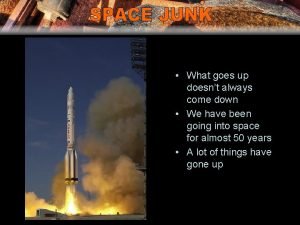What goes up doesnt always come down We


















- Slides: 18

• What goes up doesn’t always come down • We have been going into space for almost 50 years • A lot of things have gone up

• Some things have come back to Earth • They have landed or A 500 pound satellite tank burned up in the landed in a yard in Texas atmosphere, lighting missing a house by 50 yards Saturn V rocket from the up the sky much like a Apollo mission to the Moon in Earth orbit since 1969 meteor • Some have gone on to explore other worlds or space • But a lot of things are Parts of a Delta 2 still in orbit rocket fell in South Africa Meteors (from space junk? )

HARD HAT AREA? • There approximately 100 -200 space junk re-entries each year • In 2006 a woman in Tulsa, Oklahoma was hit, but not injured, by a small piece of charred metal mesh that was later confirmed to be part of a Delta II rocket launched in 1996 • But the risk that a person will be hit and injured by falling space junk is less than one in 1 trillion

A piece of space junk falls through the sky (NASA) • There is a lot of junk still going around the Earth • It can be as small as a dot of paint that came off a spacecraft • It can be as big as a spacecraft that has stopped working • There about 500 working spacecraft in orbit that must be protected

Tiny hole in the Space Shuttle Atlantis caused by space debris (NASA) Damage to the Hubble solar panel from space debris (ESA) • Space Debris in general (debris can have extraterrestrial origins as well) can be moving at speeds up to 22, 000 miles an hour • It means that even a small piece can cause a lot of damage to the Space Shuttle or the International Space Station • It can cripple satellites worth hundreds of millions of dollars • It can damage research satellites (such as the Hubble Space Telescope) • And it can even kill astronauts

• This year, after a halfcentury of growth, the federal list of orbiting detectable objects (4 inches wide or larger) reached 10, 000 • This increases the risk of large pieces smashing into each other, breaking into hundreds of pieces and creating a slow cascade of collisions that could create chaos and threaten satellites and future human space travel

Ed White making historic spacewalk in 1965 (NASA) • Astronauts have accidentally contributed to the litter • In 1965 Ed White, part of the Gemini 4 mission, lost a spare glove on his first spacewalk • The glove lost by Ed White orbited Earth with a speed of 28, 000 km/hour, becoming the most dangerous garment in history

The spatula before it floated away. It was used to repair damaged heat shield tiles (NASA) Vanguard I satellite (NASA) • In July 2006 astronaut Piers Sellers reported that he lost a spatula (it is nicknamed “spatsat”) • In 2006 a couple of bolts “escaped” as astronauts were adding a part to the ISS (at 17, 000 mph even a small bolt can hit a space shuttle with the impact of a hand grenade) • The oldest piece of space junk still in orbit is the second U. S. satellite, Vanguard I, launched on March 17, 1958, which worked for only 6 years

Skylab (NASA) • Most of the objects that reenter the Earth’s atmosphere burn up or fall into the ocean • The most spectacular re-entry was Skylab, the U. S. space station that was launched in 1973 • Most of it splashed down in the Indian Ocean in 1979, but some landed in sparsely populated western Australia • No one was injured but the U. S. Dept of State received a $400 fine for littering from the town of Esperance, Australia

Mir (ESA) Mir burns up in the sky near Fiji • In 2001 the Russian space station Mir spectacularly reentered the Earth’s atmosphere and landed in the South Pacific • Observers in Fiji saw 5 extremely bright object crossing the sky and a series of sonic booms

Photo from Fox 31 News, Denver • On January 4, 2007 at 6: 13 am the body of a Russian booster rocket broke up as it re-entered the atmosphere over Colorado & Wyoming • NORAD said it was an SL-4 rocket used to launch a French space telescope, COROT, in December • The light was described as having an extremely bright head with a tail that emitted sparks or smoke

• China’s test on January 11, 2007 of an anti-satellite (ASAT) rocket shattered an old weather satellite into thousands of large fragments • This is the worst such episode in space history • Today, next year, or next decade some of this debris may start a cascade of collisions that may expand for centuries, putting billions View of ISS orbit (green) and debris of dollars of advanced ring from the Chinese ASAT test (red) shows the debris may pose a risk to the Space Station satellites at risk (STK-generated image courtesy of CSSI)

• There is an estimated 4 million pounds of space junk in low-Earth orbit • There is roughly 110, 000 objects larger than one centimeter—each big enough to damage a satellite or space -based telescope • Although the U. S. and Russia lead the list of space junkers, other contributors include the European Space Agency, Japan, France, and India

Earth Orbit is getting very crowded • Space agencies continue to monitor the debris in space as new objects are added every few days from launches, collisions and explosions • As of now, there are no regulations controlling the generation of junk, only recommendations about minimizing it • The U. S. Space Command monitors space debris and informs NASA and other agencies when there is a threat

The side view of an impacted multi-shock shield with Nextel bumpers and a Kevlar rearwall (NASA) • Some ideas for protecting items in space have come from NASA’s Hypervelocity Impact Technology Facility • They have developed many advanced shielding concepts that will be used on the ISS • Some materials have better shielding capabilities than others and these are used in various combinations

Artist’s concept of a satellite with a tether • One suggestion for taking care of space junk include a graveyard orbit where no operational satellites are present • Another suggestion is taking satellites out of orbit at the end of their operational life • This could be aided by an electrodynamic tether that would slow down a spacecraft using atmospheric drag to cause it to fall out of orbit after a few years

• Proposals have been made to “sweep” with laser brooms to nudge small particles into decaying orbits • Or huge aerogel blobs (low-density solid-state materials) to absorb junk and fall out of orbit • Currently the most effort is in preventing collisions by keeping track of debris

• For years we have known to protect our environment on Earth • Now we know we have to protect the environment off the Earth
 What goes up and doesnt come down
What goes up and doesnt come down Come rico come sano
Come rico come sano Come in come in and sit down
Come in come in and sit down Come in come in and sit down
Come in come in and sit down All of heaven roars your name
All of heaven roars your name Doesnt really matter
Doesnt really matter King henry doesn't like chocolate milk
King henry doesn't like chocolate milk What does dna have that rna doesnt
What does dna have that rna doesnt Dont tense
Dont tense Youlust porn
Youlust porn It doesnt take
It doesnt take The catcher in the rye jane gallagher
The catcher in the rye jane gallagher Which one doesn't belong
Which one doesn't belong Fiora vvv
Fiora vvv Canyouunit
Canyouunit Goes trundling down the street
Goes trundling down the street Battle ends and down goes
Battle ends and down goes Walmart
Walmart Softly and tenderly jesus is calling
Softly and tenderly jesus is calling



































